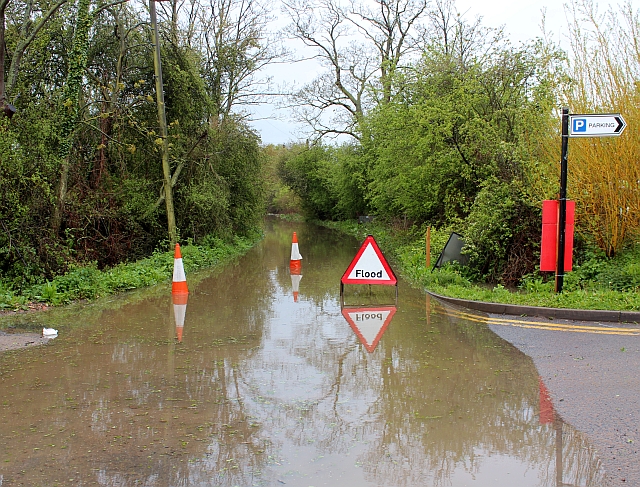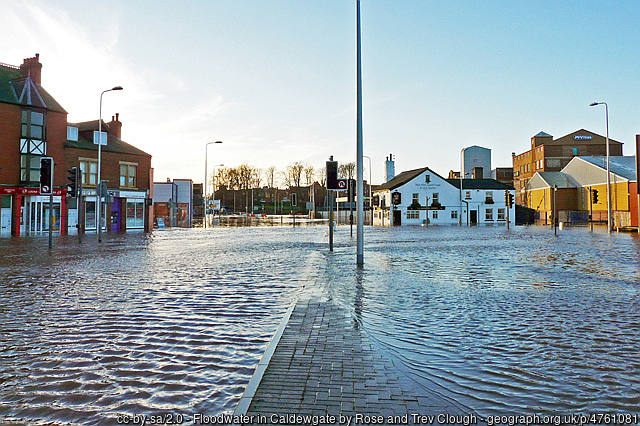This blog has been written by a member of the Newground Flood Team.
Did you know that 1 in 6 people in the England live in areas at risk of flooding? Despite this statistic, there are widespread misconceptions surrounding flooding and how it can affect you. These misconceptions can not only be dangerous, but misleading and can prevent individuals from being adequately prepared.
In this blog, we’ll uncover the common misconceptions about flooding in the UK and highlight some real life examples and easy to understand explanations, that will debunk these flooding myths.

New Street flooded – cc-by-sa/2.0 – © Bob Embleton – geograph.org.uk/p/2922279
“I have lived here for 20 years, and it’s never flooded.”
It is important to remember that just because an area has not recently flooded, this doesn’t guarantee it will never flood in the future. Take Cockermouth as an example, in 2005, it suffered a devastating flood, despite not having experienced one since 1966. This serves as a reminder that just because there has not been a flood in an area during your lifetime, does not mean that there won’t be a future flood event.

Floodwater in Caldewgate – cc-by-sa/2.0 – © Rose and Trev Clough – geograph.org.uk/p/4761081
“I live on a hill, so I won’t flood.”
Living on a hill doesn’t guarantee protection from flooding. Despite the elevated position, properties can still be affected by surface water runoff, overwhelmed sewerage pipes, high groundwater levels or burst water pipes.
Additionally, if surrounding areas flood, your property may become isolated, making it unsafe to enter or leave your local area until the floodwater withdraws. It is important to be aware of these risks and not rely solely on living on higher ground for flood protection.
“That river will never be high enough to flood me.”
Avoid presuming that a river will never reach flood levels because you haven’t witnessed it before. Even if you have never seen a river flood in your area, it does not mean it cannot happen. For instance, the River Ribble at Ribchester in Lancashire typically ranges from 0.15m to 3.9m, but it reached a record high of 5.91m during the December 2015 floods. Similarly, the River Eden in Carlisle typically ranges from 0.63m to 3.45m, but it reached a record high of 7.91m during the same floods.
“Flooding only happens in winter.”
Floods are not limited to just the winter season. In fact, flash flooding can be particularly severe during the summer months, especially when the ground is dry and hardened. During this time, the ground is unable to absorb water effectively, leading to increased runoff which can cause surface water flooding.
For instance, Coverack in Cornwall experienced flash flooding in July 2017. Localised thunderstorms followed by heavy rainfall caused rapid runoff into the village. Around 50 properties were affected as drains and waterways were overwhelmed by the sudden downpour, resulting in surface water flooding.
Another example is Boscastle in Cornwall, which suffered extensive flooding in August 2004. Very heavy rainstorms occurred near the village, causing two rivers to overflow their banks. This resulted in the surge of two billion litres of water down the valley, causing considerable damage to buildings, sweeping cars out to sea and leaving behind millions of pounds worth of devastation.
“If I acknowledge my property is in a flood risk area my insurance premiums will rise.”
You might think that if you acknowledge that your property is in a flood risk area, your insurance premiums will automatically go up. But that is not necessarily true. Insurance companies already know about properties in flood risk areas, as they have access to flood risk maps and their own data. By accepting the risk and taking steps to protect your property, such as installing property flood resilience measures, you not only reduce the chances of damage but may even have the opportunity for lower insurance premiums in the future.
It is worth noting that homeowners in flood risk areas may also benefit from the Flood Re Scheme, which offers a more affordable insurance option, without facing a significant increase in premium. If you are ineligible for the Flood Re scheme, there are also alternative flood insurance options which you can find information about here. So, by being prepared and taking precautions, you can potentially find flood insurance cover.
“We’re safe because a town nearby floods, but we didn’t flood here.”
It is important to understand that neighbouring towns can fall within different river catchment. In Lancashire, for example, Whalley is in the Calder catchment, whereas Clitheroe lies within the Ribble catchment. In December 2015, Whalley experienced severe flooding, whilst the flooding in Clitheroe was far less extensive. However, it is a misconception to assume that Clitheroe will never experience a significant flood event like that of Whalley in the future. Both areas are susceptible to flooding from localised rainfall within their respective catchments.
To be prepared for flooding, make sure you:
Even if you think your property will never flood, it is better to be prepared.
For an overview of some flooding misconceptions, download our infographic here.